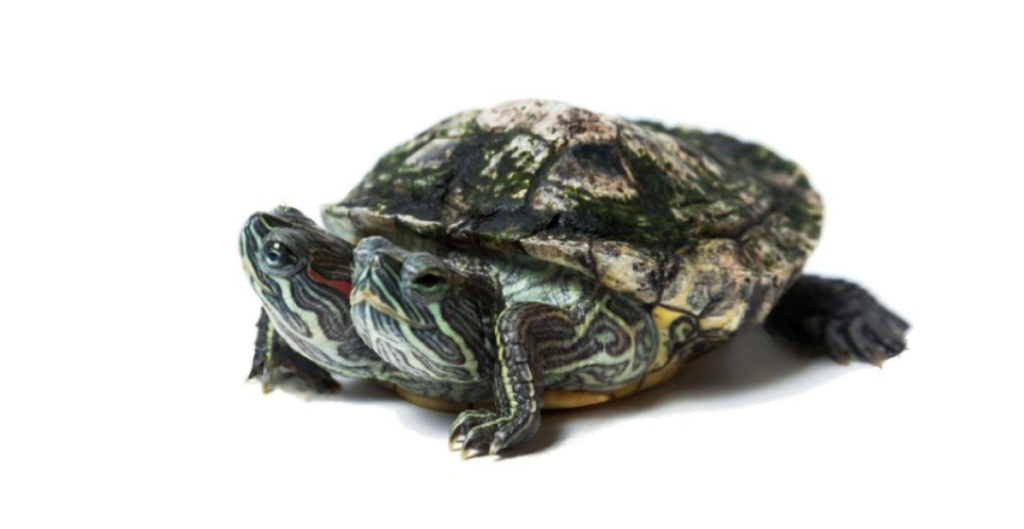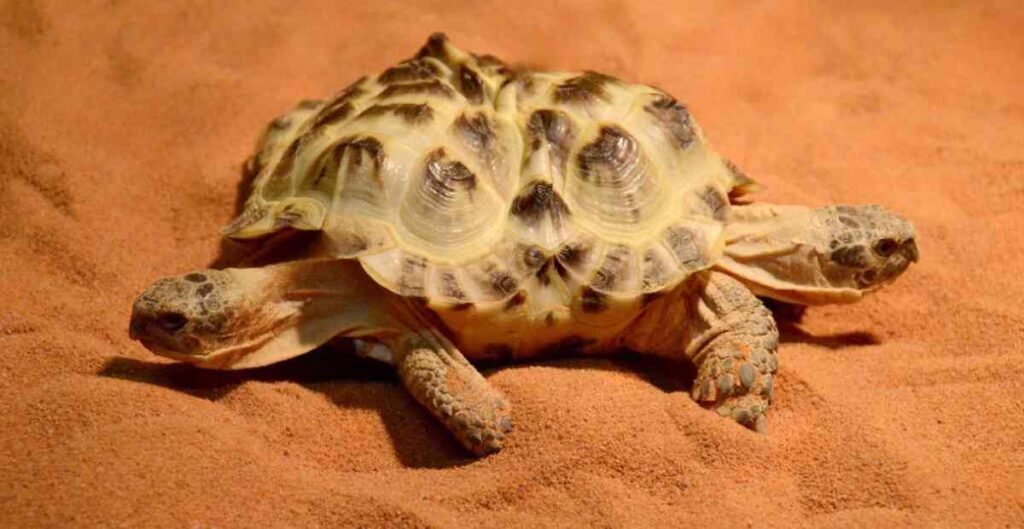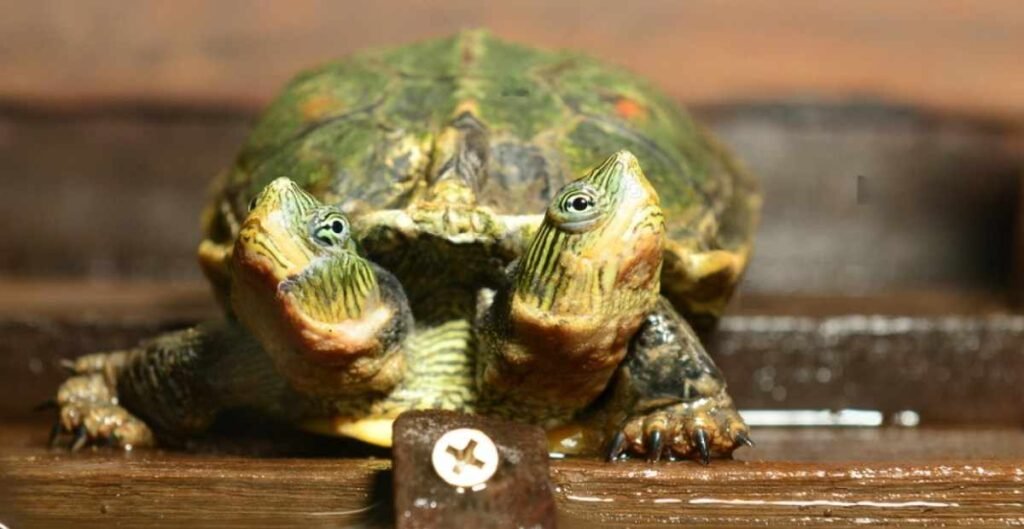You may have already experienced two-headed humans on any media platform. Now, let’s imagine you are having a good time at the beach, walking beside the sea, and suddenly, you stumbled upon a little 2 headed turtle! What would be your reaction if that little creature were a two-headed turtle? Seems like a fantasy, right? So, how common are 2 headed turtles?
Even if you encounter two-headed turtles, it is rare, like two-headed humans. However, such examples exist. Some real-life cases exist, for example—a two-headed diamondback terrapin turtle was bought by a wildlife center in Massachusetts in 2021. The reptile-like turtle moved its head independently, just like conjoined twins. When it splashed in water, one head came at a time to breathe.
Now, you must be wondering, how common are 2 headed turtles? Can you see them often? Well, you will get to know everything about it.
All About 2 Headed Turtles

When you see the word “two-headed turtles,” you can already guess they have two heads on one body. This type of extraordinary reptile is either polycephaly or bicephaly.
What Is Polycephaly
The term “polycephaly” is used for those species that have more than one head. It occurs from a polycephaly organism that creates two or more heads or beings from a single body. Then, the term “bicephaly” is used for those species that have two heads on a single body. Apart from that, the anomalies occurring in the embryonic process play a crucial role in giving two heads to a turtle.
How Polycephaly Mechanism Works?
Now, what are the primary mechanisms leading to polycephaly or bicephaly? Well, this can be caused by fission and fusion.
Fission:
In embryonic development, “fission” is the splitting of a single embryo into two separate embryos. This can result in identical twins, or if the embryo doesn’t fully split, it can result in conjoined twins. It also includes forms of polycephaly or bicephaly, where two heads develop from a single body.
Polycephaly/Bicephaly: When an embryo begins to split (as in identical twins) but does not complete the process. It can result in a single body with two heads.
Fusion
‘Fusion’ in this context refers to the scenario where two separate embryos come into close contact. It can lead to the creation of conjoined twins with two heads.
Siamese Twins: The term “Siamese twins” is a historical term for conjoined twins. When two embryos fuse together but share parts of their bodies, polycephaly or bicephaly may result.
What Causes the Two-Headed Structure in Turtles?

Sometimes we need to see some random facts rather than biological reactions to detect an uncommon feature in a species. Let’s check them out.
Temperature
Environmental factors can lead to polycyclic organisms. We know, temperature has a great hand in a turtle’s growth. If it turns out abnormal, the turtle can start developing anomalies.
Exposure
Since turtles don’t live in houses like us, they are exposed to several pollutants and toxins. This can cause physical issues, and bicephaly is one of them.
Genetic mutation
Genetic mutation means an alteration in the nucleic acid or gene’s DNA sequence, leading to the production of a different kind of offspring. Perhaps the biological parents of the two-headed turtle had a genetic mutation that differentiated cell division and gave birth to bicephaly.
Why Polycephely Occurs?
It occurs Naturally. Species like turtles have to go through embryonic development. And in its early stages, the fertilized egg divides. For any reason, errors can occur in the embryo splitting, leading to incomplete embryo division.
How Do 2 Headed Turtles Survive?

Not only is the look of two-headed reptiles extraordinary but so is their lifestyle. First is the movement. No doubt, disagreements can happen between the two heads when it comes to going somewhere or doing something. Then, their survival mode is affected. Most predators are attracted to them because of the conflicts between two heads. The risk of infections can also increase. Let’s say one head got injured and is suffering from illness; for that, the other head will also face consequences.
Two-headed animals also have physical health complications. Such as internal organ issues due to abnormal body formation, respiratory issues, spinal deformities, and so on. Compared to normal turtles, these turtles live shorter lives. This can be because of their abnormal physical structure or the mild climate.
How Common Are 2 Headed Turtles?
The 2 headed turtles are a rare case. However, there have been some incidents where people could discover polycephaly and bicephaly. Trust me, all those incidents were very convincing.
Example-1
Janus, the two-headed turtle, was once a hyped conversation in Greek. It was born in 1997. Although this turtle has one body, it has two hearts, two stomachs, two pairs of lungs, and two heads. It now resides in Geneva’s Natural History Museum. Most two-headed turtles have a shorter lifespan, but luckily, Janus still survives at 27.
Example-2
Another legitimate example of a two-headed turtle is Kumbuka and Mkia. It was born in 2012 in California. Many people have used the names of Kumbuka and Mkia to educate others on anomalies in different species.
Example-3
In the same way, Lucky and Pewee have grabbed the public’s attention since 2005. They came from Nebraska’s turtle farm; you may have heard about them in many television programs.
Example-4
Another twin-like turtle with two heads is Thelma and Louise. It was born in 2013 in Texas. Those who have visited San Antonio have surely witnessed this two-headed turtle.
Example-5
Also, in Masaceuttus, people found a diamondback terrapin turtle—we already mentioned it above. It was bought in the wildlife center of Massachusetts. After a proper inspection, veterinarians say that it’s healthy. There was a time when it was tough for a different version of the tortoise to survive. But now, many people are monitoring the growth of these turtles, leading them to a healthy lifestyle and longer lifespan.
FAQs
Is There Any Two-Headed Turtle Twins?
Two-headed turtles are considered conjoined twins, also known as bicephaly. They are mainly twins in one body and share everything. For instance, these turtles have six legs, and both of their heads control their body. Then, they share their spine but have two gastrointestinal tracts.
What Are Two Headed Turtle Facts?
Two-headed turtles have two souls in one body. They have deformities in the middle of their bodies. Since their embryos are not different from each other, they feel everything in the single body. Due to a biographical breakdown, it seems like two animals depend on each other.
Do 2 Headed Turtles Face Life Challenges?
They surely face life challenges, be it 2 headed turtles or any other 2 headed beings. It seems like you have to stay with someone forever, like glue, with no personal space. For example, if one of the heads is not taking proper nutrients, another head will face malnutrition because of the other. Also, they can have different dynamics in behavior. If one head wants to go somewhere, another head rejects it.
Final Thoughts
So, what do you think? How common are 2 headed turtles? Although uncommon, they have aroused the public’s attention like crazy. These creatures can’t live longer due to birth defects, and that’s true because of the wild climate. But if we can give them proper veterinary care, food, and a healthy environment, their life expectancy will increase. Janus (two-headed turtle) is the lead example of it. That’s why many organizations have initiated programs on how to care for 2 headed turtles instead of exploiting them for commercial or any other purpose.
